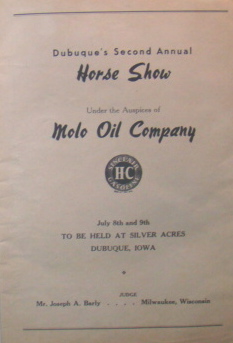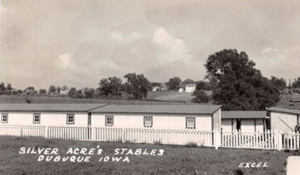Encyclopedia Dubuque
"Encyclopedia Dubuque is the online authority for all things Dubuque, written by the people who know the city best.”
Marshall Cohen—researcher and producer, CNN
Affiliated with the Local History Network of the State Historical Society of Iowa, and the Iowa Museum Association.
SILVER ACRES: Difference between revisions
No edit summary |
No edit summary |
||
| Line 5: | Line 5: | ||
During the summer of 1937, Molo planned to construct a private club house on the top of the mound. From there, guests could enjoy sheltered viewing of the races. Events could be held during the day or at night since the grounds were equipped with fourteen 500-candlepower floodlights. Management of the grounds was provided by Arthur R. (Buddy) Waite, a veteran trainer of harness horses who had been a member of the staff at the Stout farm. (3) | During the summer of 1937, Molo planned to construct a private club house on the top of the mound. From there, guests could enjoy sheltered viewing of the races. Events could be held during the day or at night since the grounds were equipped with fourteen 500-candlepower floodlights. Management of the grounds was provided by Arthur R. (Buddy) Waite, a veteran trainer of harness horses who had been a member of the staff at the Stout farm. (3) | ||
The first annual show and race meet, sponsored by the Molo Oil Company and Sinclair Refinery products, was held at Silver Acres on July 3, 1938. Among the horses entered in the two day event was "Flying King" and " I Will Shine," representing the Oakview Stables of Milwaukee, Wisconsin. (4) Events featured included hackney races, equestrienne events, and the showing and judging of five-gaited saddle horses, three-gaited saddle horses, hunters, jumpers and hackney and Shetland ponies. (5) | The first annual show and race meet, sponsored by the Molo Oil Company and Sinclair Refinery products, was held at Silver Acres on July 3, 1938. Among the horses entered in the two day event was "Flying King" and " I Will Shine," representing the Oakview Stables of Milwaukee, Wisconsin. (4) Events featured included hackney races, equestrienne events, and the showing and judging of five-gaited saddle horses, three-gaited saddle horses, hunters, jumpers and hackney and Shetland ponies. (5) The grounds became the home of the annual 4-H Show. | ||
In 1940 the three-day Dubuque County Farm Bureau 4-H Club Achievement Days Show was hosted by Silver Acres with the first annual Dubuque County Derby featuring six horses. These were not race horses, but ordinary farm horses and the riders were farm boys. Although the race with a purse of $25 donated by Mr. Molo was originally planned for one mile, the boys agreed among themselves that it should be a half-mile. (6) | In 1940 the three-day Dubuque County Farm Bureau 4-H Club Achievement Days Show was hosted by Silver Acres with the first annual Dubuque County Derby featuring six horses. These were not race horses, but ordinary farm horses and the riders were farm boys. Although the race with a purse of $25 donated by Mr. Molo was originally planned for one mile, the boys agreed among themselves that it should be a half-mile. (6) | ||
| Line 11: | Line 11: | ||
Silver Acres was the scene of the annual 4-H Achievement Show in 1948 with Saturday afternoon being given to livestock entries and the girls' exhibits. Sunday afternoon was given for a horse show including a parade of at least 116 horses classed from stock to be judged on working ability to show horses. More than $1,100 was distributed to owners of winning and high placing horses along with ribbons and prizes. The two-day event was sponsored by the Tri-State Exposition, a corporation recently organized with the goal of annually sponsoring a celebration for the benefit and entertainment of Dubuque residents. After the 4-H show became successful, it was offered to the Tri-State committee which carried it on. Bart Molo was the honorary president of the group. (7) | Silver Acres was the scene of the annual 4-H Achievement Show in 1948 with Saturday afternoon being given to livestock entries and the girls' exhibits. Sunday afternoon was given for a horse show including a parade of at least 116 horses classed from stock to be judged on working ability to show horses. More than $1,100 was distributed to owners of winning and high placing horses along with ribbons and prizes. The two-day event was sponsored by the Tri-State Exposition, a corporation recently organized with the goal of annually sponsoring a celebration for the benefit and entertainment of Dubuque residents. After the 4-H show became successful, it was offered to the Tri-State committee which carried it on. Bart Molo was the honorary president of the group. (7) | ||
[[Image:silvera.png|left|thumb|250px|Photo courtesy: Telegraph Herald]] | |||
In December, 1953 the City of Dubuque acquired Silver Acres which comprised 6.84 acres of land. In April, 1954 an additional 10.88 acres known as Slyvester Place was included by [[MOLO, William S.|William S. MOLO]]. The total cost of the two parcels, $21,760, was a gift to the city from the [[WAHLERT FOUNDATION]]. The goal of the acquisition was to construct a new recreational area containing the new municipal swimming pool. (8) The area became known as [[FLORA PARK]]. | In December, 1953 the City of Dubuque acquired Silver Acres which comprised 6.84 acres of land. In April, 1954 an additional 10.88 acres known as Slyvester Place was included by [[MOLO, William S.|William S. MOLO]]. The total cost of the two parcels, $21,760, was a gift to the city from the [[WAHLERT FOUNDATION]]. The goal of the acquisition was to construct a new recreational area containing the new municipal swimming pool. (8) The area became known as [[FLORA PARK]]. | ||
| Line 18: | Line 19: | ||
[[Image:horseshow-2.jpg|right|thumb|250px|The track was used for horse and 4-H shows. Photo courtesy: Bob Reding]] | [[Image:horseshow-2.jpg|right|thumb|250px|The track was used for horse and 4-H shows. Photo courtesy: Bob Reding]] | ||
[[Image:silveracres-3.jpg|left|thumb|250px|Program from 1949: Photo courtesy: Bob Reding]] | [[Image:silveracres-3.jpg|left|thumb|250px|Program from 1949: Photo courtesy: Bob Reding]] | ||
[[Image:moloticket.jpg| | [[Image:moloticket.jpg|center|thumb|250px|Photo courtesy: Bob Reding]] | ||
[[Image:stablessa.png| | [[Image:stablessa.png|right|thumb|300px|Photo courtesy: https://www.facebook.com/pages/You-know-you-grew-up-in-Dubuque-Iowa-if-you-remember/130170407077838]] | ||
--- | --- | ||
Revision as of 02:26, 23 March 2018
SILVER ACRES. Developed by Bart L. MOLO, the quarter-mile track located near the grounds later developed into FLORA PARK was constructed around a mound of earth from which the entire thirty-foot wide track could be seen. Mainly used for the family’s pleasure at watching trotters or fancy-stepping Hackneys, the track also stabled horses of several other owners. Molo constructed Silver Acres to share his interest in horses and to promote the idea of Dubuque becoming again one of the nation's centers of harness racing. (1)
The project of constructing Silver Acres was started in 1936 on a nine acre farm along Middle Road that later was renamed "Pennsylvania Avenue." In 1937 the farm stables sixteen horses with prospects of constructing room for more. Molo's personal stable included four pacers and trotters, a team of Hackneys, and team of ponies, two pony colts, and a saddle horse. There were several buildings including a blacksmith shop, tack room with saddles and other equipment, and a buggy shed. The latter building was a museum of antique means of transportation including a phaeton, a single-seated cutter, a two-seated sleigh, and buggies once used by some of Dubuque's most prominent families. These vehicles, all constructed at the CONNOLLY CARRIAGE MANUFACTORY, had been stored away in farm barns until the owners learned of Molo's hobby. Unlike the half-mile-long track DUBUQUE DRIVING PARK or NUTWOOD PARK for years the only mile track west of the MISSISSIPPI RIVER, the Silver Acres' track was one-quarter mile. (2)
During the summer of 1937, Molo planned to construct a private club house on the top of the mound. From there, guests could enjoy sheltered viewing of the races. Events could be held during the day or at night since the grounds were equipped with fourteen 500-candlepower floodlights. Management of the grounds was provided by Arthur R. (Buddy) Waite, a veteran trainer of harness horses who had been a member of the staff at the Stout farm. (3)
The first annual show and race meet, sponsored by the Molo Oil Company and Sinclair Refinery products, was held at Silver Acres on July 3, 1938. Among the horses entered in the two day event was "Flying King" and " I Will Shine," representing the Oakview Stables of Milwaukee, Wisconsin. (4) Events featured included hackney races, equestrienne events, and the showing and judging of five-gaited saddle horses, three-gaited saddle horses, hunters, jumpers and hackney and Shetland ponies. (5) The grounds became the home of the annual 4-H Show.
In 1940 the three-day Dubuque County Farm Bureau 4-H Club Achievement Days Show was hosted by Silver Acres with the first annual Dubuque County Derby featuring six horses. These were not race horses, but ordinary farm horses and the riders were farm boys. Although the race with a purse of $25 donated by Mr. Molo was originally planned for one mile, the boys agreed among themselves that it should be a half-mile. (6)
Silver Acres was the scene of the annual 4-H Achievement Show in 1948 with Saturday afternoon being given to livestock entries and the girls' exhibits. Sunday afternoon was given for a horse show including a parade of at least 116 horses classed from stock to be judged on working ability to show horses. More than $1,100 was distributed to owners of winning and high placing horses along with ribbons and prizes. The two-day event was sponsored by the Tri-State Exposition, a corporation recently organized with the goal of annually sponsoring a celebration for the benefit and entertainment of Dubuque residents. After the 4-H show became successful, it was offered to the Tri-State committee which carried it on. Bart Molo was the honorary president of the group. (7)
In December, 1953 the City of Dubuque acquired Silver Acres which comprised 6.84 acres of land. In April, 1954 an additional 10.88 acres known as Slyvester Place was included by William S. MOLO. The total cost of the two parcels, $21,760, was a gift to the city from the WAHLERT FOUNDATION. The goal of the acquisition was to construct a new recreational area containing the new municipal swimming pool. (8) The area became known as FLORA PARK.
---
Source:
1. "Horse Races, 'Sport of Kings,' May be Revived in Dubuque," Telegraph-Herald, February 7, 1937, p. 8
2. Ibid.
3. Ibid.
4. "Horse Show Plans Completed," Telegraph-Herald, June 26, 1938, p. 3
5. "They're Off," Telegraph-Herald, June 19, 1938, p. 10
6. "Farm Youths in Real Derby," Telegraph-Herald, September 19, 1940, p. 8
7. "Peosta Youth is 4-H Winner 2nd Year," Telegraph-Herald, September 12, 1948, p. 1
8. Kincaid, Dorothy. "New Recreational Site Studied," Telegraph-Herald, April 11, 1954, p. 9








